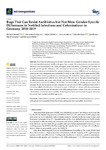2021-04-20Zeitschriftenartikel
Bugs That Can Resist Antibiotics but Not Men: Gender-Specific Differences in Notified Infections and Colonisations in Germany, 2010–2019
Brandl, Michael
Hoffmann, Alexandra
Willrich, Niklas
Reuss, Annicka
Reichert, Felix
Walter, Jan
Eckmanns, Tim
Haller, Sebastian
Data from surveillance networks show that men have a higher incidence rate of infections with anti-microbial-resistant (AMR) pathogens than women. We systematically analysed data of infections and colonisations with AMR pathogens under mandatory surveillance in Germany to quantify gender-specific differences. We calculated incidence-rates (IR) per 100,000 person–years for invasive infections with Methicillin-resistant Staphylococcus aureus (MRSA), and for infections or colonisations with carbapenem-non-susceptible Acinetobacter spp. (CRA), and Enterobacterales (CRE), using the entire German population as a denominator. We limited the study periods to years with complete notification data (MRSA: 2010–2019, CRA/CRE: 2017–2019). We used Poisson regression to adjust for gender, age group, federal state, and year of notification. In the study periods, IR for all notifications were 4.2 for MRSA, 0.90 for CRA, and 4.8 for CRE per 100,000 person-–years. The adjusted IR ratio for infections of men compared to women was 2.3 (95% confidence interval [CI]: 2.2–2.3) for MRSA, 2.2 (95%CI: 1.9–2.7) for CRA, and 1.7 (95%CI: 1.6–1.8) for CRE. Men in Germany show about double the risk for infection with AMR pathogens than women. This was also true for colonisations, where data were available. Screening procedures and associated hygiene measures may profit from a gender-stratified approach.
Dateien zu dieser Publikation

